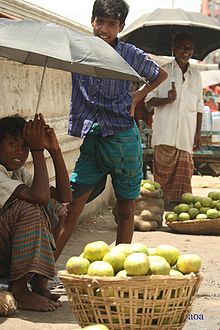- Citrus macroptera
-
Citrus macroptera 
Hatkora sellers in Sylhet, Bangladesh Scientific classification Kingdom: Plantae (unranked): Angiosperms (unranked): Eudicots (unranked): Rosids Order: Sapindales Family: Rutaceae Genus: Citrus Subgenus: Papeda Species: C. macroptera Binomial name Citrus macroptera
Montrouz.Synonyms[1] C. aurantium subsp. saponacea Saff. C. papuana F. M. Bailey
Citrus macroptera commonly called "Melanesian papeda",[1] "wild orange",[2] "cabuyao" or "satkara"[3] is a semi-wild species of citrus native to Malesia and Melanesia.[2]
Contents
Description
Citrus macroptera is so-named because of the large "wings" (-ptera) on the petiole, which is as large as the blade of the leaf.[2] The tree, which has thorns, can reach 5 m in height. Its fruit is about 6–7 cm in diamater, has a fairly smooth, moderately thick rind, and is yellow when ripe. The pulp of the fruit is greenish yellow and dry (does not produce much juice). The juice is very sour, and somewhat bitter.[2]
Varieties
The species is sometimes divided into four varieties, or alternatively into three separate species, as follows:[4]
- C. macroptera var. macroptera
- C. macroptera var. annamensis Tanaka -> C. combara Raf.
- C. macroptera var. combara (Raf.) Tanaka -> C. combara Raf.
- C. macroptera var. kerrii Swingle -> C. kerrii (Swingle) Tanaka
Cultivation
A cultivar of C. macroptera var. annamensis known as 'Sat Kara',[5] is grown primarily in the Sylhet Division of northeastern Bangladesh where it is called "hatkora" or "shatkora" (Sylheti: ꠢꠣꠔ꠆ꠇꠞ Bangla: সাতকরা|সাতকরা).
Uses
Medicinal uses
This plant is used medicinally locally in Assam.[5]
Culinary uses
In Sylhet Bangladesh the fruit is seldom consumed raw or as a juice, but is instead sliced and cooked, either green or mature, in beef, mutton, and fish curries, as well as in stews. The fruit is a primary ingredient in "hatkora/shatkora pickle".
Perfumery
Many of the C. macroptera var. annamensis fruits are exported from Bangladesh, exacting a high price because their oil is used in the perfume industry.[5]
See also
- Bangladeshi cuisine
- Citrus latipes a similar-looking species native to Northeast India
- Citrus subg. Papeda some other citrus species that resemble C. macroptera
References
- ^ a b USDA GRIN taxonomy for plants [1]
- ^ a b c d Harley I. Manner, Richard S. Buker, Virginia Easton Smith, Deborah Ward, and Craig R. Elevitch 2006. Species profiles for Pacific Island agroforestry: Citrus (citrus) and Fortunella (kumquat), Rutaceae (Rue family). pdf
- ^ Peter Hanelt (ed.) 2001 Mansfeld's encyclopedia of agricultural and horticultural crops (except ornamentals), first English edition. Springer. in Google Books
- ^ Porcher Michel H. et al. 1995–2020 (2007). Sorting Citrus Names: Multilingual Multiscript Plant Name Database (M.M.P.N.D) - A Work in Progress. School of Agriculture and Food Systems. Faculty of Land & Food Resources. The University of Melbourne. Australia. [2]
- ^ a b c M. N. Miah, Sahina Islam, and Syed Hadiuzzaman 2002. Regeneration of plantlets through somatic embryogenesis from nucellus tissue of Citrus macroptera Mont. var. anammensis (‘Sat Kara’). Plant Tissue Culture and Biotechnology 12(2):167-172 pdf
External links

This Rutaceae article is a stub. You can help Wikipedia by expanding it.
